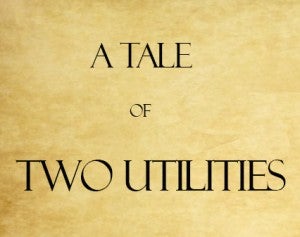UPDATE: A tale of two utilities: One Illinois power provider looks ahead, while the other won’t budge
 Energy Exchange published an original version of this post in July 2016. This post updates the original to reflect recent developments in Illinois.
Energy Exchange published an original version of this post in July 2016. This post updates the original to reflect recent developments in Illinois.
As a utility executive, it is the best of times, it is the worst of times. It is the age of innovation, it is the age of stagnant tradition. With a nod to Charles Dickens, it is the epoch of environmental improvement, it is the epoch of continued pollution.
Perhaps no state better represents those extremes than Illinois, where Commonwealth Edison (ComEd) in the north is considering new business models and embracing greenhouse-gas reductions, while Ameren in the south is rejecting change and virtually anything related to clean energy.
Consider energy efficiency. ComEd recently celebrated $2.5 billion in customer savings as a result of efficiency, and will invest $350 million each year for the next four years in energy efficiency programs. Ameren on the other hand, is trying to get out of the efficiency targets it agreed to as part of the Future Energy Jobs Act. The historic bipartisan legislation included provisions to double Illinois’ energy efficiency portfolio, meaning the state’s two largest utilities – ComEd and Ameren – would significantly up their efficiency efforts.
Yet Ameren is trying to go back on its word and asking the Illinois Commerce Commission to break the Future Energy Jobs Act agreement. The utility recently filed a proposal that would fall short of the legislation’s energy efficiency savings goals – by 27 percent – for the next four years.
Rejecting efficiency is not just an affront to the lungs of Ameren’s customers – since cutting energy waste reduces the need to burn dirty coal – it also drains the pocketbooks of the southern Illinois utility’s customers, because efficiency is by far the cheapest means to ensure reliable electricity.
[Tweet “One Illinois Power Provider Looks Ahead, while the Other Won’t Budge”]
Consider, moreover, the calculation of greenhouse-gas reductions. ComEd has adopted an EDF-CUB metric for evaluating how utility investments reduce pollution. Ameren wants to delay its adoption.
Rejecting performance metrics is also an affront to basic business economics, which maintains companies should be rewarded relative to how they reach their goals. Rebuffing measurements harms Ameren’s customers, too, who must continue to buy power from the utility without any guarantee the company will reduce pollution.
The introduction and rapid advance of new technologies offers enormous opportunities to increase and improve energy services.
The introduction and rapid advance of new technologies – including sophisticated sensors, smart electric meters, and advanced communications – offers enormous opportunities to increase and improve energy services. ComEd feels these innovations require changes to the utility business model, which for the past several decades featured risk-averse and inefficient monopolies. The northern Illinois firm sees the potential for moving from a pipeline business – which simply pushes electrons through its wires – to a dynamic platform, which would profit by enabling entrepreneurs and others to help supply both power and new amenities.
Ameren, in contrast, seems trapped in the past, hoping it can ignore new technologies, as well as new economics that favor efficiency and clean energy. Such a backward-focused approach may be more comfortable for executives who are accustomed to guaranteed profits, but it will ultimately hurt the utility as new firms invest in innovation and customers adopt efficiency and distributed energy resources.
The power sector is changing. No doubt EDF will continue pushing ComEd to be more aggressive in its clean energy efforts, but in the meantime, we’re happy to see the utility embracing energy efficiency and emerging energy technologies. Ameren executives, in contrast, hope they can ignore the desires of their customers, the needs of the environment, and the challenges of new competitors. While no one claims to know with certainty what the future holds, one Illinois utility is willing to look forward; the other is stuck in the status quo.











